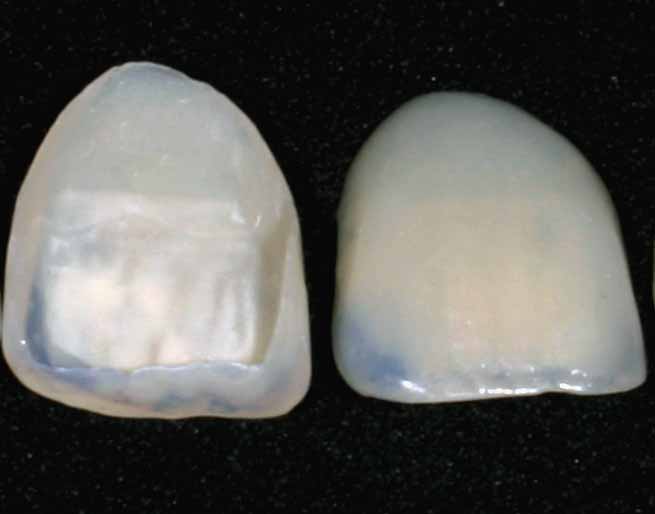
This quick guide will walk you through all you need to know about composite veneers.
In dentistry, placing a thin layer of material onto a tooth is known as dental laminates or veneers. Wikipedia describes a veneer as
“a layer of material placed over a tooth, veneers improve the aesthetics of a smile and/or protect the tooth’s surface from damage.”

Clausgast [CC BY-SA 3.0 (https://creativecommons.org/licenses/by-sa/3.0)]
Composite veneers, also known as “composite bondings”, “componeers”, “same-day veneers” or “resin veneers”, is a less invasive cosmetic dental procedure that involves placing a layer of resin material directly onto a tooth. It is generally used to improve the shape, colour, size, and texture of the teeth to make them more attractive.
If you have chipped, worn, or damaged teeth, a composite veneer can be applied directly on the teeth as a fix and produce, beautiful, life-like results. The procedure is different from dental bridges, dental crowns, and dental fillings, all of which are more functional than aesthetic treatments. They are also different from porcelain veneers, in that they require little or no teeth reduction (drilling), and the procedure can be completed in a single visit.
The composite resin veneers can be installed on as many teeth as you choose. If you want a full smile makeover, the total cost can be as much as a fifth of the cost of regular porcelain veneers.
Dental composite resin is a specially designed material developed for use in dentistry. It’s primarily a paste, which is applied onto a tooth and then sculpted like putty. When the desired shape of tooth is achieved, it’s hardened using special light in a process referred to as light curing, and then polished. The new veneer surface ideally hides the old one that might be worn out, discoloured, damaged, or just non-aesthetic.
These composite materials are quite advanced, and are continually being improved for more translucent, life-like results. Composites are safe and effective, which explains why they are used in millions of dental cases worldwide to improve the aesthetics of a patient’s smile.
The key difference is that composite veneers are typically built onto the tooth’s surface, while porcelain veneers are first moulded to fit the prepared teeth, and then sent to a lab to actually make them. The porcelain veneers are then glued (cemented) onto the tooth in subsequent appointments.
Porcelain veneers typically require preparation before they are fitted. This entails drilling down the original teeth into a special shape for the final veneer to fit. However, touching any teeth with a drill increases the chance that the tooth will get damaged or worse, die off. It also increases the risk that you will need a root canal in the future, and in some cases, the patient might need implants to restore the tooth as time takes a toll on the drilled tooth.
Another key difference is that composite veneers can be made and installed in just one visit to the dentist. The procedure typically takes anything from under an hour to a few hours to complete, and the results will be instant.
In comparison, porcelain veneers require multiple steps and a few appointments to install. Your teeth will have to be prepped first and get temporary veneers installed while you wait for the final veneer fitting. The dentist will also have to work with a master ceramist to create porcelain veneers in a lab. Of course, this takes time and will translate into higher costs.
The first thing your dentist will do is examine your teeth and mouth to determine if you’re a suitable candidate for composite veneers. It’s important that you don’t have any form of inflammation or active gum disease before any cosmetic procedure is performed.
During the initial consultation, the dentist will also determine the current colour of your teeth and have you decide the desired colour of your final teeth. If you want to have whiter teeth, then a teeth whitening procedure might be performed before the veneers are placed, so that the veneers can be colour-matched to the surrounding natural teeth. Keep in mind that you might need to top up your teeth whitening periodically to maintain a white smile.
Next, your teeth are cleaned thoroughly to remove any surface build-up of plaque, to provide a clean surface to place the veneers. Your teeth will then be dried well and isolated with a rubber dam to remove any saliva or moisture present, as this might interfere with the bonding process. The front part of your teeth will then be etched with acid to roughen the surface chemically. This helps the composite material to adhere onto the teeth’s surface more effectively.
The binding agent is then applied to the surface of the etched teeth, and the composite material is slowly added in layers to build up the tooth. The processes is repeated to add, remove, and mould the composite material. This is followed by polishing, which ideally creates the final veneer. Of course, the final result is highly dependent on the skills of your cosmetic dentist.
This will largely depend on how you look after your teeth and veneers. For instance, if you suffer from bruxism (teeth grinding), the composites will crack and chip as normal teeth would. Your dentist can make you a custom night guard to help keep the veneers in a great condition for long. However, since biting food and chewing hard food is part of most diets, normal wear and tear is unavoidable. And depending on your diet and chewing habits, composite veneers can last anywhere between 2 and 8 years.
Composite veneers are generally a much better value solution compared to porcelain veneers, although this can depend on the patient and the treatment.
BACK to BlogTo find out if composite veneers are right for you, visit our dental clinics in Liverpool or Southport or book a free consultation. Contact us here.
“I’d become a little nervous visiting dentists in the last few years. Dr Khan, however, has totally restored that confidence since coming to Puredental. Highly...”
“Dr Dee is very understanding of nervous patients. When I first visited him, I was very anxious; Dr Dee took the time to explain every...”
“I couldn’t be happier with my experience at Puredental. Dr Rohan was friendly and professional and did a fantastic job from start to finish with...”
“I am really happy with the results of my Invisalign braces. The whole process has been straightforward and very swift. I can highly recommend Puredental....”
“I cannot recommend Dr Khan and the team at Puredental enough. I was terrified of dentists and had avoided them for years, and as a...”
“I would like to say a big thank you to Dr Khan and all the amazing staff as I was very nervous about visiting a...”
“Dr Rohan is fab; I am so pleased with my new smile. I would definitely recommend his services and all the girls are lovely, too.”
“Today, I have completed my transformation. Dr Khan has made such a difference using Invisalign clear braces alongside composite bonding. He is exceptional and clearly...”
“The staff at Puredental were so lovely and welcoming. I’m so happy with the outcome of my Invisalign & composite bonding by Dr Rohan. He...”
“I came to see Dr Rohan 18 months ago after years of wanting to improve my smile. He put me at ease straight away and...”
“The wife received a 1st-class service from Mr Khan and cannot praise him enough. I cannot recommend him highly enough.”
“Dr Kahn and his team were great. He made me feel at ease and calmly talked through the process. Would recommend.”
“Dr Khan is an amazing dentist! I've always hated the dentist and been terrified of going, but Dr Khan puts me completely at ease. I'm...”
“I have not long finished my Invisalign journey, and I am so pleased with the results! Thank you, Dr Khan.”
“Very professional and honest.”
“Great clean.”
“Good customer care. It is clean and polished. Comprehensive advice on preventing future problems. Altogether, it was a good experience.”
Stay connected with Puredental! Follow us on social media for the latest updates, exclusive offers, and dental tips to keep your smile shining bright.
View our Instagram








